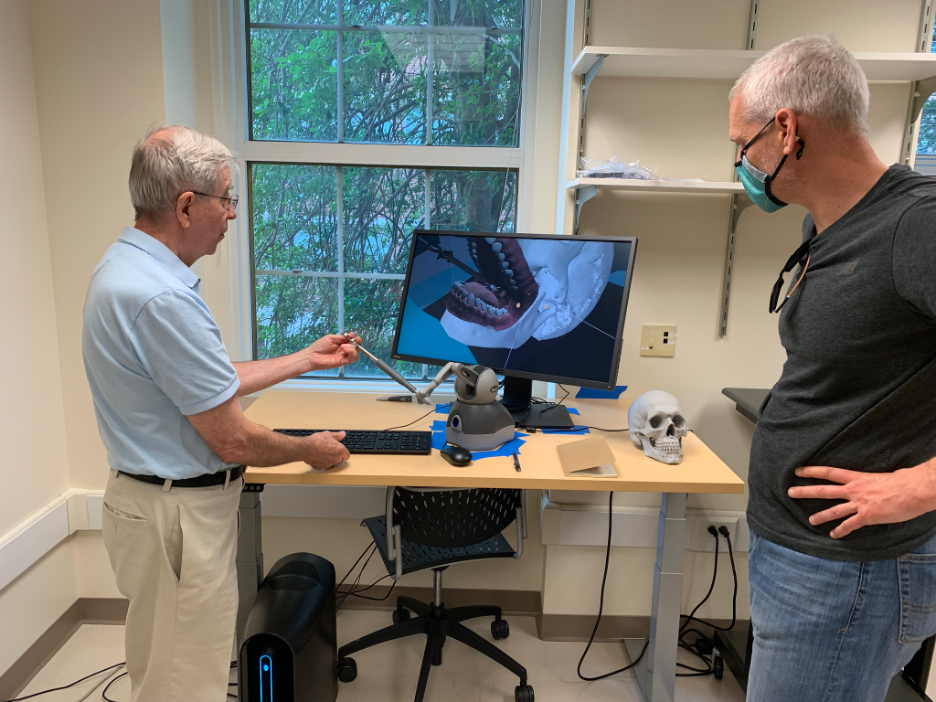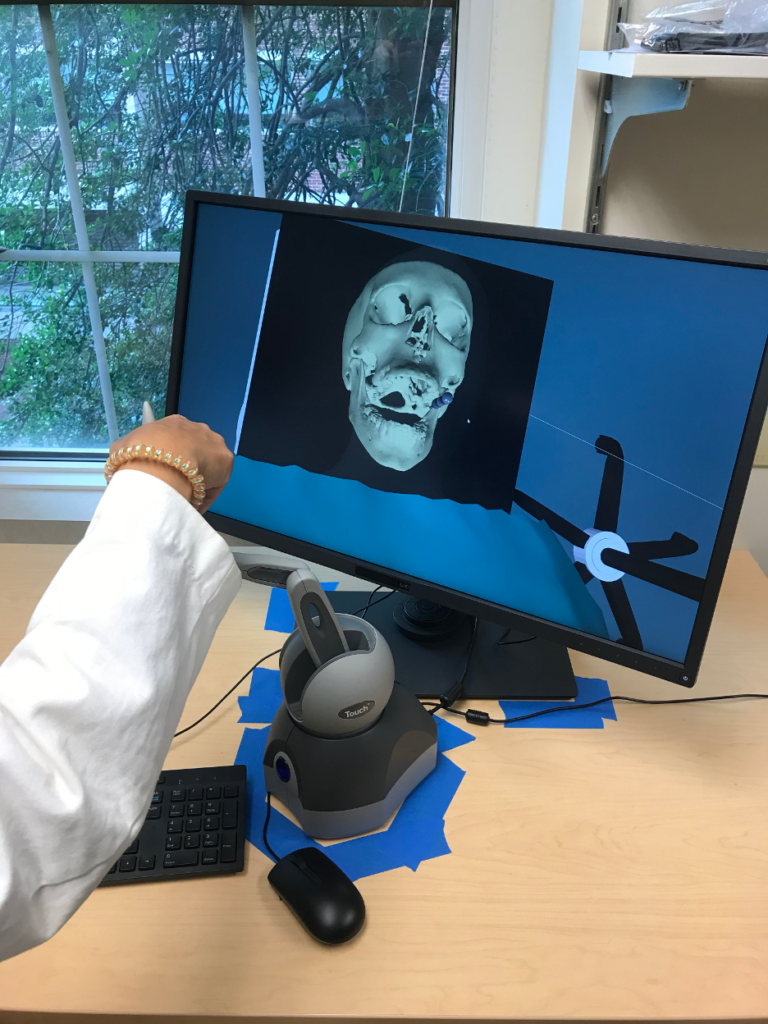Successful Demonstrations of Kitware’s Virtual Osteotomy and Gow-Gates Nerve Block Trainers

In an effort to continue improving our medical training tools, Kitware presented the Virtual Osteotomy Trainer and the Gow-Gates Anesthesia Trainer to subject matter experts (SMEs) at the University of North Carolina (UNC) at Chapel Hill School of Dentistry to gather clinical feedback. These trainers were implemented using iMSTK, Kitware’s open source toolkit that aids rapid prototyping of interactive multi-modal surgical simulations. iMSTK is the framework for real-time physics, haptics (touch), collision, and advanced rendering with a focus on medical simulation. Qt QML is the user interface markup language and the 3D input and haptic output interface were developed using a 3DSystems Touch device.
VIRTUAL OSTEOTOMY TRAINER
The Virtual Osteotomy Trainer is a virtual reality-based oral and maxillofacial surgical trainer. It can be used to improve procedural knowledge and surgical proficiency during orthognathic surgery. One of the featured surgical training scenarios is a bisagittal split osteotomy (BSSO). BSSO is a complicated type of jaw surgery that requires precision. BSSO is when the lower jaw is separated from the face and repositioned to correct skeletal malocclusions. The Osteotomy Trainer can increase the efficiency of surgical training, including complex surgeries such as BSSO, in a risk-free training environment.
How it Works
To prepare for the BSSO procedure, the Virtual Osteotomy Trainer assembles the scene using geometries from scanned CT data. During the real-life procedure, the surgeon uses a saw to remove material from the cortical bone. To apply this to our virtual setting, a new algorithm was developed for haptic-enabled bone material removal. The bone is modeled as a level set while the tool is modeled as a pointset. The algorithm is then able to compute rigid body collisions and erosion of the level set at greater than 1khz speeds. Many complex optimizations were made to achieve these rates which are important for stable haptic feedback (see iMSTK 4.0 release). To see a demonstration of the Virtual Osteotomy Trainer, watch this video.

Clinical Expert Feedback
Dr. Elda Fisher, director of the oral and maxillofacial residency program at UNC’s Adams School of Dentistry, is an experienced oral and maxillofacial surgeon. She was able to successfully perform the BSSO cut in our Osteotomy trainer prototype (Figure 1). However, she did experience some issues with tool placement in the virtual setting. Observing her and talking through some of these difficulties gave us additional features to consider. She felt that the haptics were working very well and that the response she got from the device matched what she expected to feel. But since she had trouble locating the tool in the scene and positioning it correctly, we will focus on making improvements to the rendering to boost depth perception. We also received feedback regarding other features we should include, like a form of path planning for the procedure and audio feedback for newer students.
GOW-GATES NERVE BLOCK TRAINER
The Gow-Gates nerve block is a common technique used in dental procedures. It’s a nerve block of the inferior alveolar nerve that relies on the deposition of local anesthetic adjacent to the head of the mandibular condyle. It blocks almost all branches of the mandibular division of the trigeminal nerve.
How it Works
The implementation of this procedure is much more straightforward than BSSO. The graphics and physics are handled by iMSTK and the team utilized Kitware’s open source Visualization Toolkit (VTK) for its physically-based rendering capabilities that result in a very realistic representation of the mouth.

Clinical Expert Feedback
Dr. Glenn Reside, clinical professor at UNC’s Adams School of Dentistry, has been teaching the course to perform dental anesthesia injections for the past few decades. When he used the Gow-Gates Nerve Block Trainer, he liked the haptics and how it felt as the needle was touching the bone, which is a critical step for this procedure. However, we discovered that the adapter we 3D printed to allow users to hold an actual syringe threw off the haptics. Our intentions were to incorporate a real syringe to help users learn the correct hand position, but in doing so, it affected our haptic device which caused undesirable vibrations because of the lack of user control. We will redesign the attachment and syringe construction for the next demonstration.
PLANS FOR FUTURE IMPROVEMENTS
Kitware was pleased that both trainers were very well received by the SMEs. The surgeons liked the haptics and felt that the forces represented through the trainers when touching anatomy or sawing through bone matched their real-life experience. We look forward to applying their feedback so we can continue to improve these platforms. This feedback will also help us enhance iMSTK with respect to defining structures and patterns that deal with overall simulation applications items.
ABOUT KITWARE’S MEDICAL COMPUTING TEAM
Kitware’s Medical Computing Team is an industry leader in the use of artificial intelligence and machine learning technology for the analysis of medical images and data. Our team is composed of computer scientists, software engineers, and imaging experts who have been working with medical and biomedical customers for more than 20 years. We have domain expertise in visualization and application development, medical image analysis algorithms, and simulation. We can provide support throughout the entire process, from determining the feasibility of a project to deploying solutions across a wide range of computing environments, to contributing to the regulatory submission. We operate as an extension of your team and truly get to know your specific challenges and needs. If you’re interested in learning more or would like to schedule a meeting with our Medical Computing Team, please email us at kitware@kitware.com.
Acknowledgment
This work was supported by The National Institutes of Health (NIH) National Institute for Dental and Craniofacial Research (NIDCR), project High-fidelity Virtual Reality Trainer for Orthognathic Surgery R44DE027595 (Osteotomy Trainer), and by funds obtained from the Dean’s Funds from the School of Dentistry of the University of North Carolina at Chapel Hill (Anesthesia Injection Trainer).